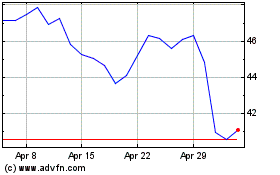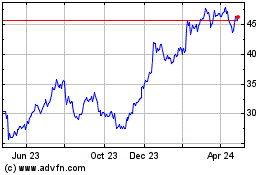WASHINGTON—A former National Security Agency contractor amassed
at least 500 million pages of government records, including
top-secret information about military operations, by stealing
documents bit by bit over two decades, the Justice Department
alleged in a court filing submitted Thursday.
Prosecutors in August arrested and charged Harold "Hal" Martin
III, of Glen Burnie, Md., with theft of government property and
unauthorized removal or retention of classified documents. The case
was kept under seal until earlier this month, when some details
became public.
The new filing said the Justice Department would likely charge
Mr. Martin with additional crimes, including violating the
Espionage Act, an offense that carries much stiffer penalties than
the current charges.
Mr. Martin's attorney, Jim Wyda, declined to comment on the new
filing. In the past, he has said that Mr. Martin is a patriotic
American who has served his country.
A federal court has scheduled a hearing for Friday to consider
whether Mr. Martin should be released while awaiting trial. The
Justice Department released its 12-page document ahead of that
hearing, detailing new allegations about the scope of Mr. Martin's
alleged theft and suggesting he had become heavily armed,
accumulating 10 weapons, and had taken sophisticated steps to cover
his tracks.
Some former associates had described Mr. Martin as a harmless
hoarder who suffered from post-traumatic stress disorder. The new
government filing paints a different picture, raising questions
about his motives and suggesting he was capable of sharing U.S.
secrets with the nation's adversaries and potentially putting
American lives at risk.
The document doesn't, however, answer one of the big questions
in the case: whether Mr. Martin shared any of the stolen classified
information with another person or another country. The document
offers no evidence that he did but suggested Mr. Martin had the
capacity to do so.
Mr. Martin, a former Naval officer, was most recently a
contractor at Booz Allen Hamilton Holding Corp., a job that placed
him inside some of the government's most secretive programs inside
the NSA and the Pentagon. The Justice Department said that a search
of his home and his automobile uncovered "thousands of pages of
documents and dozens of computers and other storage devices and
media containing, conservatively, fifty terabytes of
information."
Fifty terabytes is equivalent to 50,000 gigabytes. One gigabyte
can contain 10,000 pages of documents, the department
estimated.
By extrapolation, 50 terabytes can hold 500 million pages.
In seeking Friday's hearing, Mr. Martin's legal team wrote that
he "is neither a flight risk nor a danger to the community, and to
the extent either of these factors is a concern, they can be
sufficiently addressed with specific release conditions."
The Justice Department countered Thursday that Mr. Martin
"presents a high risk of flight, a risk to the nation, and to the
physical safety of others."
Mr. Martin worked on highly sensitive programs, people familiar
with the investigation have said, including those involving an
arsenal of cybertools the government has amassed to use against
other countries as well as cyberweapons that were in
development.
So far, it is unknown what Mr. Martin intended and what, if any,
plans he had for the pilfered information.
When the Federal Bureau of Investigation searched Mr. Martin's
home and car in August, it found much of the stolen information in
plain sight. Top-secret information was stored in his car, which
wasn't parked in a garage. Investigators also found an email chain
printed out in that car that was marked "top secret" and contained
"highly sensitive information."
They also found handwritten notes that appeared to describe the
NSA's classified computer infrastructure, the Justice Department
said in its filing.
"Among the many other classified documents found in the
Defendant's possession was a document marked as 'Top
Secret/Sensitive Compartmented Information' ('TS/SCI') regarding
specific operational plans against a known enemy of the United
States and its allies," the court document said.
Government lawyers argued that releasing Mr. Martin would
present an obvious danger.
"As a result of the extensive publicity this case has received,
it is readily apparent to every foreign counterintelligence
professional and nongovernmental actor that the Defendant has
access to highly classified information, whether in his head, in
still-hidden physical locations, or stored in cyberspace—and he has
demonstrated absolutely no interest in protecting it," the Justice
Department said. "This makes the Defendant a prime target, and his
release would seriously endanger the safety of the country and
potentially even the Defendant himself."
The filing described Mr. Martin as computer genius who easily
outsmarted government efforts to protect secrets and said he
possessed an advanced understanding of how to encrypt messages and
hide information in cyberspace.
In July 2016, according to the document, Mr. Martin went to
Connecticut and bought a "detective special" police-package
Chevrolet Caprice. The FBI found 10 firearms in his possession,
including an AR-style tactical rifle and a shotgun with a flash
suppressor.
Scott Calvert contributed to this article.
Write to Damian Paletta at damian.paletta@wsj.com
(END) Dow Jones Newswires
October 20, 2016 17:55 ET (21:55 GMT)
Copyright (c) 2016 Dow Jones & Company, Inc.
Carlyle (NASDAQ:CG)
Historical Stock Chart
From Jun 2024 to Jul 2024

Carlyle (NASDAQ:CG)
Historical Stock Chart
From Jul 2023 to Jul 2024
